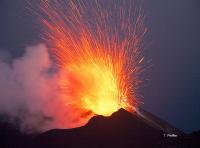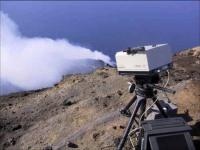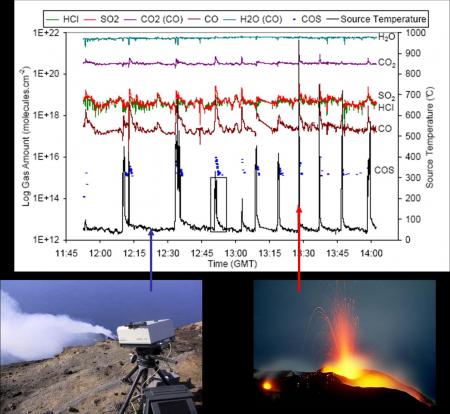M. Burton, F. Muré, A. La Spina, Istituto Nazionale di Geofisica e Vulcanologia, Catania, Italy



A Strombolian type explosion at Stromboli. (9th of October 2006, Stromboli, photo T. Pfeiffer).
News regularly point out all the beauty but also the potential dangers of volcanic eruptions. If one can appreciate the show of these natural phenomena, one also seeks to understand them better in order to protect the neighbouring populations and to evaluate their impact on the climate evolution.
Eruptions at Stromboli (Italy) occur as periodic explosions (~15 mn) projecting fragments of molten lava to a few hundred meters above the crater. This type of explosions, so-called "Strombolian", is observed on many volcanoes worldwide, among which Mount Etna as again verified recently. The driving mechanism of the explosions is well known: large gas pockets (slugs) that are formed by coalescence of small bubbles at depth in the magma rise rapidly across the volcanic conduits and bursts explosively while reaching the surface. However, the depth of origin of these gas slugs remained uncertain; it was indirectly estimated from the analysis of seismic and acoustic signals associated with the explosions. In a new study published in "Science" (July 2007, [1]), researchers from the Pierre Sue Laboratory (CNRS-CEA, Saclay) and the National Institute of Geophysics and Volcanology of Italy (INGV, Catania) determine for the first time the depth of origin of strombolian explosions.
For this, an Open Path-Fourier Transform Infrared spectrometer (OP-FTIR) was used to measure the complete chemical composition of magmatic gases (H2O, CO2, SO2, HCl, HF, CO, COS, etc...) emitted between and during the explosions, based on the absorption spectra of the infrared radiation emitted by the lava.
This remote sensing technique allows safe measurements, simultaneous detection of all gas components, and data collection at a high temporal resolution (every 4 seconds). It was set up on Mount Etna for routine gas monitoring since 2000 and, in particular, it allowed the determination of the origin of powerful lava fountains (continuous gas and lava columns several hundred of meters high) on this volcano [2].

Drawing of the source depth of gas pockets driving strombolian explosions (adapted by INSU from the National Geographic).
At Stromboli, the measurements revealed that the chemical composition of the explosive gas pockets strongly differs from that of quiescent gas emissions between the explosions. Using an outgassing model for Stromboli magma, based on the analysis of its dissolved volatile components as studied within the LPS for several years [3], it was inferred that the gas pockets actually form and rise separately from 3 km under the crater. They find thus their origin from as deep as the volcano basis (located at -2000 m below the Tyrrhenian Sea level). This is ten times deeper than previously estimated from geophysical data (~250 m), thus modifying noticeably our understanding of the explosions and of the approaches needed for their forecasting.
This research demonstrates the high interest to the monitoring of magmatic gas by OP-FTIR spectroscopy for a better knowledge of the mechanisms controlling explosive volcanic activity. In particular, it opens new perspectives for predicting the paroxysmal explosions which, 2 to 3 times per year, hit the Stromboli and constitute a major danger for tourists, but also… volcanologists and occasionally the inhabitants of the island! A better model of the eruptions drawn from these data will also allow a better quantification of the volcanic gas contributions to the atmosphere and their potential impact on the climate.
References :
[1] Magmatic gas composition reveals the source depth of slug-driven strombolian explosive activity, M. Burton, P. Allard, F. Muré, A. La Spina, Science, 317 (2007) 227
[2] Spectroscopic evidence for a lava fountain driven by previously accumulated magmatic gas. P. Allard, M. Burton and F. Muré, Nature, 433 (2005) 407.
[3] Crystallization driven by decompression and water loss at Stromboli Volcano (Aeolian Islands, Italy), N. Métrich, A. Bertagnini, P. Landi, M. Rosi, J. Petrology, 42-8 (2001) 1471-1490.
Stromboli volcano (Aeolian Archipelago, Italy): An open window on the deep-feeding system of a steady state basaltic volcano, A. Bertagnini, N. Métrich, P. Landi, M. Rosi, J. Geophys. Res. 108, B7 (2003) 2336.
•  Physics and chemistry for life sciences and the environment › Environmental chemistry and pollution control (Earth science)
Physics and chemistry for life sciences and the environment › Environmental chemistry and pollution control (Earth science)













